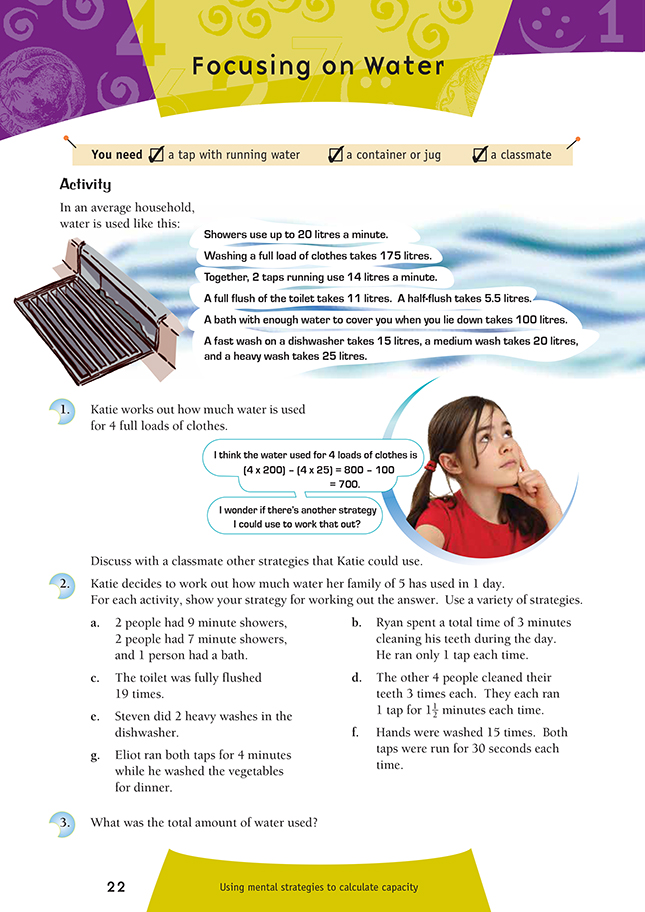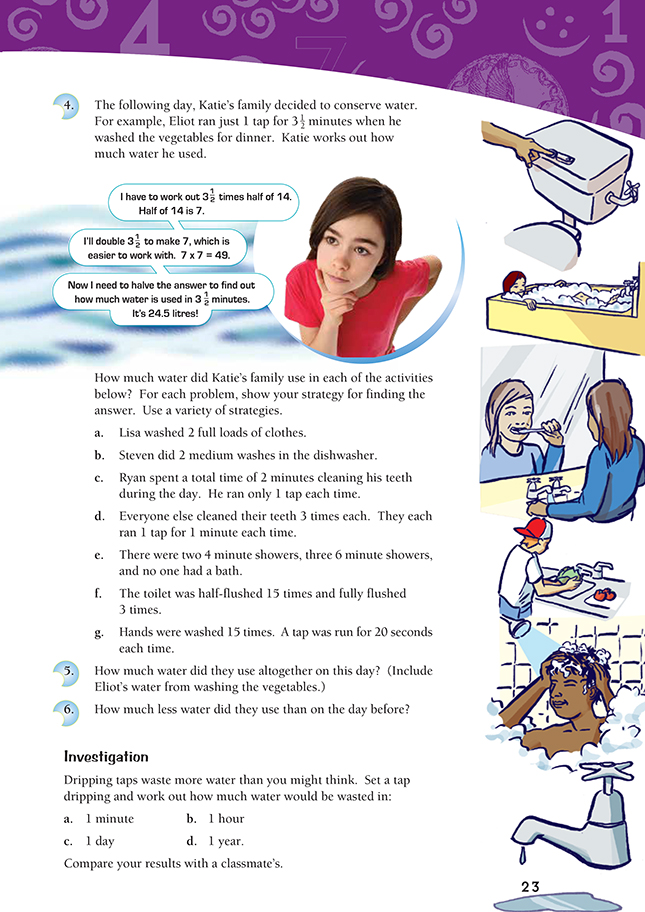This is a level 4 number activity from the Figure It Out series. It relates to Stage 7 of the Number Framework.
A PDF of the student activity is included.
Click on the image to enlarge it. Click again to close. Download PDF (518 KB)
use multiplicative strategie to solve problems (tidy numbers, partitioning, doubles and halves)
A tap with running water
FIO, Level 3-4, Number, Book 2, Focusing on Water, pages 22-23
Container or jug
A classmate
Activity One
Students doing this activity should be advanced additive or in transition to advanced multiplicative. The use of capacity and rates reinforces a variety of mental multiplicative part–whole strategies. You could use the think, pair, and share model (see the notes for pages 2–3) to get the students to share their strategies and also to discuss why some methods are easier to use than others. See the Answers for some suggested strategies. Other appropriate strategies include tidy numbers (for example, for question 2c, 19 x 11 = 20 x 11 – 11), standard place value and partitioning
(for example, for 2f, 15 x 30 = 10 x 30 + 5 x 30), and doubling and halving (for example, for 2g, 4 x 14 = 8 x 7).
Some of the questions require the students to use their answers from earlier questions, so encourage them to check their answers as they go along to avoid getting an incorrect answer because of an earlier miscalculation. Also, in question 4d, the students need to remember that they are dealing with 4 people (the family consists of 5 people, including Ryan, who has already been dealt with in question 4c).
Investigation
This investigation has strong links to environmental education and science strands as well as to statistics. See also the comments on investigations in the notes for page 11.
The students will need to select appropriate units and equipment for measuring. The frequency and size of the drips will vary between groups, but it is assumed that, for a given tap, the drip rate will stay the same. More extensive ideas for focusing on water investigations are available in the following resources:
McCabe, Elizabeth (1998). “Testing the North River”. Connected 2 1998.
Building Science Concepts Books 1 and 15.
Answers to Activity
1. Strategies will vary. Another possible strategy is:
4 x 100 = 400, 4 x 50 = 200, 4 x 25 = 100.
400 + 200 + 100 = 700.
2. Strategies will vary. At least one possible strategy is included for each answer.
a. 740 L. (2 x 9 x 20) + (2 x 7 x 20) + 100
= 360 + 280 + 100
= 740
b. 21 L. 3 x 14 ÷ 2 = (3 x 15 – 3) ÷ 2
= 42 ÷ 2
= 21
or: 1/2 x 14 x 3 = 7 x 3 = 21
c. 209 L. 19 x 11 = 10 x 11 + 10 x 11 – 11
= 110 + 110 – 11
= 220 – 11
= 209
or: 19 x 11 = (19 x 10) + (19 x 1)
= 190 + 19
= 209
d. 126 L. 1 tap uses 7 L a min, so 4 x (3 x 1.5 x 7) = 126.
e. 50 L. 25 + 25 = 50 or 2 x 25 = 50
f. 105 L. 2 taps for 30 s = 1 tap for 1 min.
15 x 7 = 10 x 7 + 5 x 7
= 70 + 35
= 105
g. 56 L. 4 x 14 = 4 x 15 – 4
= 60 – 4
= 56
or: 14 x 2 x 2 = 28 x 2 = 56
or: 4 x 10 + 4 x 4 = 40 + 16 = 56
3. 1 307 L (the total of the amounts in question 2)
4. Strategies will vary. One possible strategy is included for each answer.
a. 350 L. 2 x 100 + 2 x 75 = 200 + 150 = 350
b. 40 L. 20 + 20 = 40
c. 14 L. 2 x 7 = 14
d. 84 L. 4 x 3 x 7 = 84
e. 520 L.
(2 x 4 x 20) + (3 x 6 x 20) = 160 + 360 = 520
f. 115.5 L.
3 x 11 = 33.
15 x 5.5 = (10 x 5 + 5 x 5) + (10 x 0.5 + 5 x 0.5)
= (50 + 25) + (5 + 2.5)
= 75 + 7.5
= 82.5
82.5 + 33 = 115.5
g. 35 L. 15 x 20 s = 300 s or 5 min.
5 x 7 = 35
5. 1 183 L (the total of the amounts in question 4 + Eliot’s 24.5)
6. 124 L. (1 307 – 1 183)
Investigation
Results will vary.

